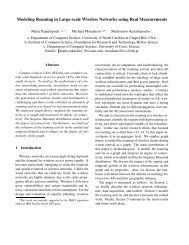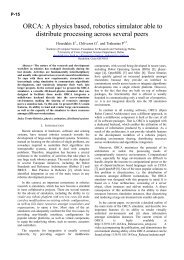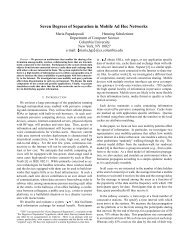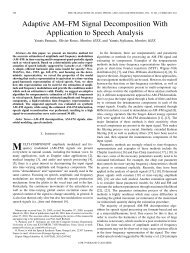Faceted Taxonomy-based Information Management - ICS
Faceted Taxonomy-based Information Management - ICS
Faceted Taxonomy-based Information Management - ICS
Create successful ePaper yourself
Turn your PDF publications into a flip-book with our unique Google optimized e-Paper software.
Name Notation Definition<br />
terminology T a set of names, called terms<br />
subsumption ≤ a preorder relation (reflexive and transitive)<br />
taxonomy (T , ≤) T is a terminology, ≤ a subsumption relation over T<br />
faceted taxonomy F= {F 1 , ..., F k } F i = (T i , ≤ i ), for i = 1, ..., k and all T i are disjoint<br />
compound term over T s any subset of T (i.e., any element of P(T ))<br />
compound terminology S a subset of P(T ) that includes ∅<br />
compound ordering ≼ s ≼ s ′ iff ∀t ′ ∈ s ′ ∃t ∈ s such that t ≤ t ′<br />
broaders of s Br(s) {s ′ ∈ P(T ) | s ≼ s ′ }<br />
narrowers of s Nr(s) {s ′ ∈ P(T ) | s ′ ≼ s}<br />
broaders of S Br(S) ∪{Br(s) | s ∈ S}<br />
narrowers of S Nr(S) ∪{Nr(s) | s ∈ S}<br />
object domain Obj any denumerable set of objects<br />
interpretation of T I any function I : T → 2 Obj<br />
model of (T , ≤)<br />
induced by I Ī Ī(t) = ∪{I(t ′ ) | t ′ ≤ t}<br />
materialized (F, I) F is a faceted taxonomy {F 1 , ..., F k },<br />
faceted taxonomy<br />
I is an interpretation of T =Ëi=1,k T i<br />
Table 1. Basic notions and notations<br />
2 Compound Term Composition Algebra<br />
The Compound Term Composition Algebra (CTCA) was<br />
proposed for defining the meaningful compound terms over<br />
a faceted taxonomy in a flexible and efficient manner. The<br />
problem of meaningless compound terms and the effort<br />
needed to specify the meaningful ones is a practical problem<br />
identified even by Ranganathan himself [6] (about 80<br />
years ago). This is probably the main reason why faceted<br />
taxonomies have not dominated every application domain<br />
despite their uncontested advantages over the single taxonomies.<br />
CTCA is the only well-founded and flexible solution<br />
to this problem. Table 1 recalls in brief the basic<br />
notions around taxonomies, faceted taxonomies, and materialized<br />
faceted taxonomies (for more refer to [14, 13]).<br />
CTCA has four basic algebraic operations, namely, plusproduct<br />
(⊕), minus-product (⊖), plus-self-product, ( ∗ ⊕), and<br />
minus-self-product ( ∗ ⊖). All these are operations over P(T ),<br />
the powerset of T , where T is the union of the terminologies<br />
of all facets. The initial operands, thus the building<br />
blocks, of the algebra are the basic compound terminologies,<br />
defined as: T i = Br({{t} | t ∈ T i }), where T i is the<br />
terminology of the facet F i , i = 1,...,k. An expression e<br />
over F is defined according to the following grammar:<br />
e ::= ⊕ P(e, ..., e) | ⊖ N (e, ..., e) |<br />
∗<br />
⊕ P T i |<br />
∗<br />
⊖ N T i | T i,<br />
where the parameters P and N denote sets of valid and<br />
invalid compound terms over the range of the operation,<br />
respectively. Roughly, CTCA allows specifying the valid<br />
compound terms over a faceted taxonomy by providing a<br />
small set of valid (parameter P ) and a small set of invalid<br />
(parameter N) compound terms. The self-product operations<br />
allow specifying the meaningful compound terms over<br />
one facet. Specifically, the definition of each operation of<br />
CTCA is summarized in Table 2, where S i , i = 1,...,n, are<br />
compound terminologies. If e is an expression, S e denotes<br />
the outcome of this expression and is called the compound<br />
terminology of e. In addition, (S e , ≼) is called the compound<br />
taxonomy of e.<br />
An expression e is well formed iff every facet appears<br />
at most once in e, and the parameter sets P and N are always<br />
subsets of the corresponding set of genuine compound<br />
terms. Specifically, each parameter P (resp. N) of an operation<br />
⊕ P (e 1 ,...,e k ) (resp. ⊖ N (e 1 ,...,e k )) should be subset<br />
of the set of genuine compound terms over the compound<br />
terminologies S e1 ,...,S ek , i.e., subset of:<br />
G Se1 ,...,S ek<br />
= S e1 ⊕ ... ⊕ S ek − ∪ k i=1S ei<br />
From an application point of view, another important remark<br />
is that there is no need to store the set of valid compound<br />
terms that are defined by an expression, as the algorithm<br />
IsV alid(e,s) (given in [14]) can check whether<br />
a compound term s belongs to the set of compound terms<br />
defined by an expression e (i.e., whether s ∈ S e ) in polynomial<br />
time. Specifically, the computational complexity of<br />
this algorithm is O(|T | 3 ∗|s|∗|P∪N |), where P denotes the<br />
union of all P parameters and N denotes the union of all N<br />
parameters appearing in e. Thus, only the faceted taxonomy<br />
F and the CTCA expression e need to be stored. Note that<br />
|T | is not expected to be very large, in a faceted taxonomy.<br />
As an example, recall the faceted taxonomy of Figure 1.<br />
One can easily see that several compound terms over this<br />
faceted taxonomy are meaningless, in the sense that they<br />
cannot be applied to any object of the domain. For instance,<br />
we cannot do any winter sport in the Greek islands (Crete<br />
and Kefalonia) as they never have enough snow, and we<br />
cannot do any sea sport in Olympus because Olympus is a<br />
mountain. For the sake of this example, let us also suppose<br />
that only in Kefalonia there exists a hotel that has a casino,
















